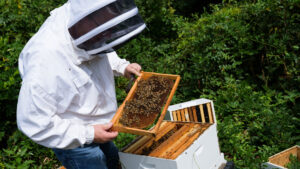April 2020 Research Roundup

A look at some of the latest published research from the NC State College of Veterinary Medicine.
Histiocytic Sarcoma in Miniature Schnauzers
Research co-authored by James Elliott looks at clinical presentation and outcomes for the largest group of miniature schnauzers with histiocytic sarcoma (HS) studied at one time.
The study, published in the Journal of Small Animal Practice, looked at a collection of samples from dogs diagnosed from 2008 and 2019 with the aggressive cancer, most commonly seen in Bernese mountain dogs, flat-coat retrievers and Rottweilers.
The retrospective study confirms many earlier findings on canine histiocytic sarcoma and concludes that HS should be considered as a differential diagnosis in miniature schnauzers with pulmonary masses.
Read the study here.
Establishing Antibiotic Doses for Brown Pelicans
A single intramuscular injection of the antibiotic danofloxacin at a dose of 15 mg/kg body weight in rehabbed California brown pelicans meets therapeutic targets for bacteria, according to a study co-authored by Mark Papich.
The study, published in the Journal of Avian Medicine and Surgery, notes the dose can be used for future studies evaluating the effectiveness of danofloxacin in treating susceptible bacteria.
Read the study here.
Treating Pulmonary Fibrosis
Idiopathic pulmonary fibrosis has no cure and few treatment options. A new study outlines a treatment approach using lung spheroid cells to treat the lethal lung disease.
The study, published in Stem Cells Translational Medicine, outlines the safety and efficacy of lung spheroid cells derived from fibrotic lungs as therapeutic agents, as well as their potential for clinical translation. Study authors include Ke Cheng, Kenneth Adler, Taylor Hensley, Phuong-Uyen C. Dinh and Jhon Cores.
Read the study here.
Detecting Canine Seizures
Generalized seizures in dogs can be detected with a type of collar-mounted accelerometer, but the overall sensitivity is low, according to new research from Karen Muñana, Peter Early and Julie Nettifee.
Many dogs with idiopathic epilepsy continue to have seizures despite treatment. The research assessed the use of a commercially available collar-mounted accelerometer based on dog owner observations and video recordings. The study’s algorithm accurately detected about 20% of seizures; the device was more successful in discriminating activities that were not seizures.
A common canine neurological disorder, idiopathic epilepsy is characterized by recurrent, unprovoked seizures believed to result from genetic predisposition. The Journal of Veterinary Internal Medicine published the research.
Read the study here.
Infectious Diseases in Honeybees

A study from Olivia Petritz and Jeffrey Applegate explores infectious diseases of honeybees, illuminating information helping to guide veterinary care for the insect.
Following honeybees’ reclassification as food-producing animals, knowledge of the insect’s disease and biosecurity helps develop a robust veterinary client-patient relationship with apiarists, the study states.
The diseases discussed in the study, published in Veterinary Clinics of North America: Exotic Animal Practice, include the highly infectious bacterial disease American foulbrood and European foulbrood; the microsporidial disease Nosema which affects the gastrointestinal tract of honeybees; and varroosis, which severely impacts hive health and virus transmission and is caused by a parasitic mite.
Read the study here.
Strengthening Tendon Repairs
A type of suture increases the biomechanical strength of canine tendon repairs, according to a study co-authored by Daniel Duffy.
Published in Veterinary and Comparative Orthopaedics and Traumatology, finds that the addition of an interlocking horizontal mattress epitendinous suture (HIMES) to a three-loop pulley core suture significantly reduced gap formation between tendon ends. The study notes that further testing is needed to evaluate the suture pattern’s effect on tendinous blood supply.
Read the study here.
Bacterial Infections in Poultry
A study finds that commercial probiotic direct-fed microbial Calsporin (CSP) and prebiotic mannan oligosaccharide IMW50 protect the ileal mucosal integrity in young turkeys exposed to Salmonella or Campylobacter.
The research, co-authored by Oscar Fletcher and published in Poultry Science, found the number and size of villi reduced in exposed poults after using the drugs. Salmonella and Campylobacter bacteria are major worldwide health burdens. Poultry are known to be one of the main reservoirs of these zoonotic pathogens, the study states.
Read the study here.
Analyzing Jumping Behaviors in Cats to Track Pain
A new model to characterize activity monitor data signatures for movements performed by cats successfully identified various jumps in healthy felines, a step that could improve diagnosis of underlying signs of pain, according to a study co-authored by Duncan Lascelles.
Cats in the study were fitted with an activity monitor that was overwhelmingly successful in identifying jumps up, down and across. The ability to objectively identify such clinically relevant movements could improve both diagnosis of pain and the ability to accurately assess treatment. A next step is developing a model for clinical use in cats with osteoarthritis or degenerative joint disease.
There is a general lack of refined approaches to assess mobility and activity in companion animals, according to the study, published in the American Journal of Veterinary Research.
Read the study here.
~Jordan Bartel/NC State Veterinary Medicine


